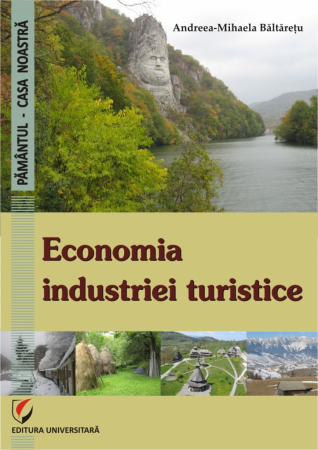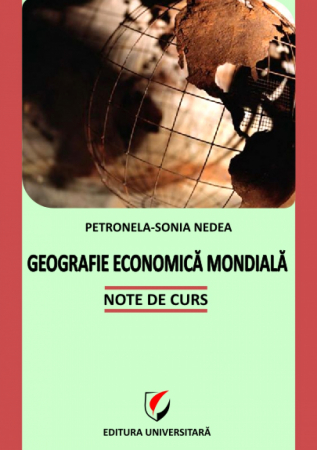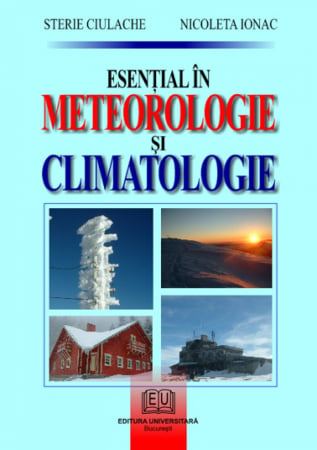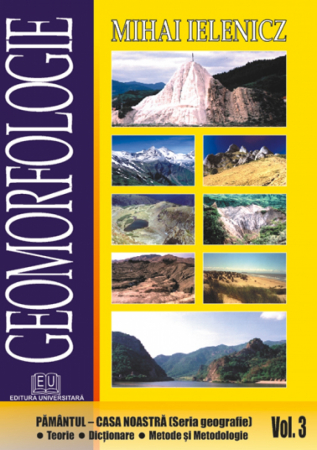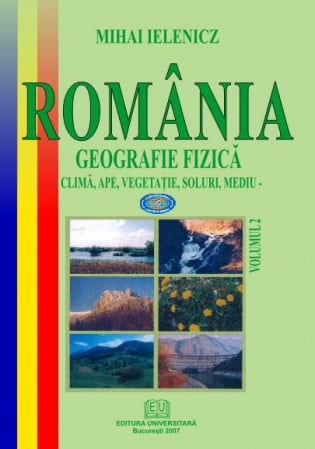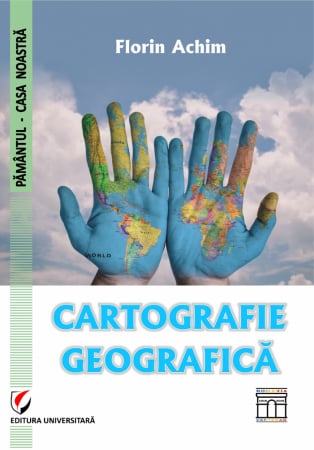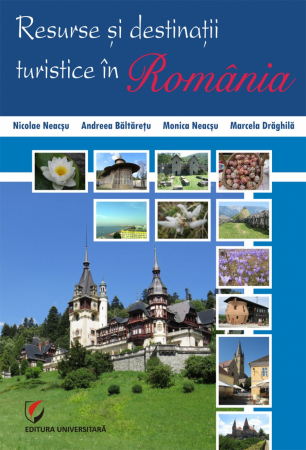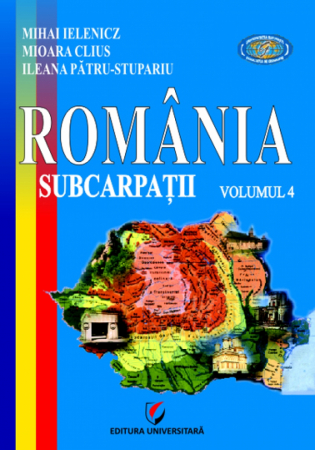Manuscript proposals: [email protected] / 0745 204 115 //// Tracking orders Individuals / Sales: 0745 200 357 / Orders Legal entities: 0721 722 783
ISBN: 978-606-591-046-1
Publisher year: 2010
Edition: II
Pages: 256
Publisher: Editura Universitară
Author: Ion Pişota, Liliana Zaharia, Daniel Constantin Diaconu
Product Code:
9786065910461
Do you need help?
0745 200 357
- Description
- Download (1)
- Authors
- Content
- More details
- Reviews (0)
This paper is addressed mainly to students from different fields and specializations within the Faculty of Geography of the University of Bucharest, who attend both full-time courses and forms of Open Distance Education (IDD) organized by CREDIS and Education with Low Frequency (IFR). At the same time, the paper can be useful to geography teachers in pre-university education in order to prepare for obtaining different teaching degrees, as well as to all those interested in the field of hydrology.
The course is structured in four main parts, which cover the essential issues of continental hydrology: I. General problems of hydrology; II. Groundwater (Hydrogeology); III. River hydrology (Potamology); IV. Notions of limnology, telmatology and glaciology. The chapters were provided at the end with recapitulative self-assessment questions, which would allow students on the one hand to check how they understood and mastered the basic information contained in that chapter, and on the other hand, to and fix this information. In order to highlight the important terms to remember, they were written in different characters (bold, italic, bold italic). Also, at the end of each of the four major parts, syntheses of important notions and terms were made, which would allow once again the students to recapitulate and fix them and, finally, their thorough acquisition.
As the own investigation activity is particularly important in the acquisition and understanding of knowledge, and hydrology involves numerous practical activities, some control topics are proposed in the course. These put students in the situation either to develop the problems presented in the course by consulting additional materials, or to apply concretely some theoretical knowledge presented in the course, by solving problems that involve calculations and measurements on morphohydrological parameters. The realization of the control topics is largely based on the consultation of the practical works included at the end of the major topics of the course, works that contain detailed examples of solving some practical problems.
The course is structured in four main parts, which cover the essential issues of continental hydrology: I. General problems of hydrology; II. Groundwater (Hydrogeology); III. River hydrology (Potamology); IV. Notions of limnology, telmatology and glaciology. The chapters were provided at the end with recapitulative self-assessment questions, which would allow students on the one hand to check how they understood and mastered the basic information contained in that chapter, and on the other hand, to and fix this information. In order to highlight the important terms to remember, they were written in different characters (bold, italic, bold italic). Also, at the end of each of the four major parts, syntheses of important notions and terms were made, which would allow once again the students to recapitulate and fix them and, finally, their thorough acquisition.
As the own investigation activity is particularly important in the acquisition and understanding of knowledge, and hydrology involves numerous practical activities, some control topics are proposed in the course. These put students in the situation either to develop the problems presented in the course by consulting additional materials, or to apply concretely some theoretical knowledge presented in the course, by solving problems that involve calculations and measurements on morphohydrological parameters. The realization of the control topics is largely based on the consultation of the practical works included at the end of the major topics of the course, works that contain detailed examples of solving some practical problems.
-
Hydrology
Download
ION PISOTA
LILIANA ZAHARIA
DANIEL DIACONU
LILIANA ZAHARIA
DANIEL DIACONU
Introduction / 7
PART ONE
GENERAL HYDROLOGY PROBLEMS
1. General notions of hydrology. The spread and circulation of water on the globe (I.P., L.Z.) / 9
1.1. The object and problems of hydrology / 9
1.2. The connection of hydrology with other sciences and the fields of application of hydrology / 10
1.3. Research methods in hydrology / 11
1.4. Water distribution worldwide / 11
1.5. The water circuit in nature and the hydrological balance / 14
1.5.1. Local water circuit / 14
1.5.2. The universal water circuit. Hydrological balance / 15
1.5.3. The main processes and components of the water circuit in nature / 17
2. Water and its general properties. Water pollution and protection (L.Z.) / 22
2.1. General properties of liquid water / 22
2.1.1. Physical and organoleptic properties / 22
2.1.2. Chemical properties / 25
2.1.3. Biological and bacteriological properties / 28
2.2. Water pollution and actions regarding the protection and conservation of their quality / 28
2.2.1. Water pollution / 28
2.2.2. Actions regarding the protection and conservation of water resources / 29
2.2.3. Water quality and protection in Romania / 30
3. The importance of water in nature and for socio-economic activities (I.P., L.Z.) / 33
3.1. The role of water in natural processes / 33
3.1.1. The role of water in geochemical and geophysical processes / 33
3.1.2. The role of water in biological processes / 33
3.1.3. The influence of water on the climate / 34
3.1.4. The role of water in relief modeling / 34
3.2. The importance of water for socio-economic activities / 35
3.2.1. Feeding the population / 35
3.2.2. Power supply industry / 36
3.2.3. Water as a means of communication / 36
3.2.4. Water as an energy source / 37
3.2.5. The importance of water for irrigation / 37
3.2.6. Water as a source of food and raw materials / 38
3.2.7. The role of water in tourism, leisure and health activities / 39
4. Water resources and their capitalization in tourism (L.Z.) / 39
4.1. Aquatic units and their tourist potential / 39
4.2. Types of tourism favored by the capitalization of aquatic resources / 42
4.2.1. Maritime coastal tourism / 42
4.2.2. Spa cure tourism / 43
4.2.3. Lake tourism / 44
4.2.4. Mountain tourism / 44
5. Control Themes (L.Z.) / 45
PART TWO
GROUNDWATER (HYDROGEOLOGY)
6. General notions of hydrogeology (I.P., L.Z.) / 47
6.1. The origin of groundwater and theories on their formation / 47
6.2. Hydrogeological properties of rocks / 48
6.3. Rock water categories / 51
6.4. Vertical groundwater distribution / 53
6.5. Groundwater circulation / 54
6.5.1. Groundwater circulation factors / 54
6.5.2. Laminar and turbulent movement of groundwater / 55
6.5.3. The main parameters that characterize the groundwater drain / 56
6.5.4. Groundwater drainage direction / 58
7. Aquiferous layers (I.P., L.Z.) / 60
7.1. General considerations / 60
7.2. Free (groundwater) aquifers / 62
7.2.1. General characteristics / 62
7.2.2. Feeding of groundwater aquifers / 62
7.2.3. Types of groundwater aquifers / 64
7.3. Captive (deep) aquifer layers and their typology / 67
7.4. Piezometric level and its variation regime / 68
7.4.1. Factors influencing the oscillation of the piezometric level / 68
7.4.2. Piezometric level oscillation regime / 69
7.5. Romania's groundwater resources and their quality / 70
8. Springs (I.P.) / 72
8.1. Classification of sources / 72
8.1.1. Classification of sources according to the geological situation / 72
8.1.2. Classification of springs by temperature / 77
8.1.3. Mineral waters / 78
8.1.3.1. Definition, genesis, typology / 78
8.1.3.2. Geographical spread of mineral springs in Romania / 79
8.1.4. Flat water / 82
9. Practical works and control topics (D.D., L.Z.) / 84
9.1. Preparation of thematic maps on groundwater with hydrohypsips and hydroisobates / 84
9.1.1. Preparation of the map with hydrohypsips / 84
9.1.2. Determining the direction of groundwater flow / 88
9.2. Control themes / 90
PART THREE
RIVER HYDROLOGY (POTAMOLOGY)
10. The river basin and its characteristic elements (L.Z.) / 93
10.1. Cumpana de ape / 93
10.2. Elements that characterize the river basin / 94
11. Hydrographic network (I.P.) / 101
11.1. The main forms of water drainage / 101
11.1.1. Temporary drainage waters / 101
11.1.2. Permanently drained waters / 102
11.2. The hierarchy of the hydrographic network / 104
11.3. Elements that characterize the hydrographic network / 104
12. Valley of the rivers (I.P.) / 106
12.1. Genesis and elements of the valleys / 106
12.2. Longitudinal and transversal profile of the riverbed / 110
12.2.1. Longitudinal profile / 110
12.2.2. The transversal profile of the river and its hydraulic elements / 112
13. River water dynamics (I.P., L.Z.) / 114
13.1. River water speed / 115
13.1.1. General considerations / 115
13.1.2. Flowing water speed measuring devices / 117
13.2.3. Determination of the average water speed / 119
14. River water level (I.P., L.Z.) / 121
14.1. Devices of determination of river water level / 121
14.2. Water level measurement / 124
14.3. Level processing / 125
15. Water flow (I.P., L.Z.) / 128
15.1. Methods for determining the water flow / 128
15.1.1. Determination of water flow by section-speed method, using hydrometric grinder / 129
15.1.2. Direct methods for determining water flow / 131
15.1.2.1. Volumetric method / 131
15.1.2.2. Chemical method (of dilution) / 131
15.1.2.3. Method of hydrometric discharges and calibrated channels / 132
15.1.3. Determination of water flows using the limnimetric key / 133
15.2. Water flow processing / 135
15.2.1. Characteristic flows / 135
15.2.2. Graphic methods for processing liquid flows / 136
16. River water runoff (I.P., L.Z.) / 138
16.1. River supply / 139
16.2. Factors of river runoff / 139
16.3. Ways of expressing river water runoff / 141
16.4. The main types of leaks / 142
16.4.1. Average runoff / 143
16.4.2. Maximum leakage / 144
16.4.3. Minimum leakage / 144
16.5. Extreme hydrological phenomena / 145
16.5.1. The floods / 145
16.5.2. River erosion and drying / 147
16.6. Hydrological regime of rivers / 148
16.7. Hydrological balance of rivers / 149
17. Alluvium runoff (solid runoff) (L.Z.) / 151
17.1. The formation of alluvium and the factors that influence it / 151
17.2. Alluvium in suspension / 152
17.2.1. Ways of expressing the discharge of alluvium in suspension / 152
17.2.2. Determination of the flow of alluvium in suspension / 153
17.2.2.1. Collection and filtration of suspended alluvium samples / 154
17.2.2.2. Calculation of the flow of alluvium in suspension / 154
17.2.3. Processing of suspended alluvium flows / 156
17.3. Drained and sedimented alluvium / 157
18. Thermal and freezing regime of rivers (I.P., L.Z.) / 158
18.1. River water temperature / 158
18.2. River freezing regime / 160
19. River Water Chemistry (L.Z.) / 162
20. Practical works and control topics (D.D., L.Z.) / 165
20.1. Morphometric characteristics of the river basin / 165
20.1.1. Delimitation of the river basin by tracing the watershed / 167
20.1.2. Determination of the surface of the river basin / 167
20.1.3. Morphometric characteristics of the river basin / 171
20.2. Morphometric characteristics of the hydrographic network / 179
20.3. Measurement of water speed and liquid flow using hydrometric miorist / 184
20.4. Control topic / 188
PART THE FATHER
NOTIONS OF LIMNOLOGY, TELMATOLOGY AND GLACIOLOGY
21. Lakes and their classification according to the origin of lake basins (I.P., L.Z.) / 190
21.1. General considerations / 190
21.2. The origin of lakes and their classification according to the genesis of the basin / 191
21.2.1. The lakes resulting from the action of internal factors / 191
21.2.2. The lakes resulting from the action of external factors / 194
22. The main morphological and morphometric elements of lakes (I.P., L.Z.) / 201
22.1. The main morphological elements / 201
22.2. The main morphometric elements / 202
23. Lake water dynamics (I.P.) / 205
23.1. Permanent movements / 205
23.2. Periodic movements / 206
24. Lake water balance and level variations regime (I.P.) / 209
24.1. Lake water balance / 209
24.2. Regime of level variations / 210
25. Lake water temperature (I.P., L.Z.) / 212
25.1. General considerations / 212
25.2. Types of thermal stratification of lakes / 213
25.3. Typology of lakes according to thermal stratification / 214
25.3.1. Holomic Lakes / 214
25.3.2. Meromictic lakes / 216
25.4. The freezing and thawing regime of the lakes / 217
26. Physical and chemical characteristics of lake water (I.P.) / 218
26.1. Transparency and color of water in lakes / 218
26.2. The chemical composition of the lakes and their classification according to the degree of mineralization / 218
26.3. Gases from lake water / 220
27. Life in the water of lakes (I.P., L.Z.) / 221
28. Elements of lake hydrometry (L.Z.) / 222
29. Notions of telmatology (I.P.) / 225
29.1. Genesis and typology of swamps / 225
29.2. Hydrological regime of swamps / 226
29.3. The spread of swamps and their economic importance / 226
30. Notions of glaciology (I.P., L.Z.) / 227
30.1. Climatic limit of permanent snow and glacier formation / 227
30.2. The movement of glaciers / 229
30.3. Types of glaciers / 229
30.4. Glacier exercise processes / 231
30.5. Geographical spread of glaciers and their hydrological importance / 233
31. Practical works and control topics (D.D., L.Z.) / 234
31.1. Elements of lake bathymetry / 235
31.2. Elements of lake morphometry / 238
31.3. Water balance of lakes / 240
31.4. Control themes / 243
Bibliography / 244
Photographic images / 246
PART ONE
GENERAL HYDROLOGY PROBLEMS
1. General notions of hydrology. The spread and circulation of water on the globe (I.P., L.Z.) / 9
1.1. The object and problems of hydrology / 9
1.2. The connection of hydrology with other sciences and the fields of application of hydrology / 10
1.3. Research methods in hydrology / 11
1.4. Water distribution worldwide / 11
1.5. The water circuit in nature and the hydrological balance / 14
1.5.1. Local water circuit / 14
1.5.2. The universal water circuit. Hydrological balance / 15
1.5.3. The main processes and components of the water circuit in nature / 17
2. Water and its general properties. Water pollution and protection (L.Z.) / 22
2.1. General properties of liquid water / 22
2.1.1. Physical and organoleptic properties / 22
2.1.2. Chemical properties / 25
2.1.3. Biological and bacteriological properties / 28
2.2. Water pollution and actions regarding the protection and conservation of their quality / 28
2.2.1. Water pollution / 28
2.2.2. Actions regarding the protection and conservation of water resources / 29
2.2.3. Water quality and protection in Romania / 30
3. The importance of water in nature and for socio-economic activities (I.P., L.Z.) / 33
3.1. The role of water in natural processes / 33
3.1.1. The role of water in geochemical and geophysical processes / 33
3.1.2. The role of water in biological processes / 33
3.1.3. The influence of water on the climate / 34
3.1.4. The role of water in relief modeling / 34
3.2. The importance of water for socio-economic activities / 35
3.2.1. Feeding the population / 35
3.2.2. Power supply industry / 36
3.2.3. Water as a means of communication / 36
3.2.4. Water as an energy source / 37
3.2.5. The importance of water for irrigation / 37
3.2.6. Water as a source of food and raw materials / 38
3.2.7. The role of water in tourism, leisure and health activities / 39
4. Water resources and their capitalization in tourism (L.Z.) / 39
4.1. Aquatic units and their tourist potential / 39
4.2. Types of tourism favored by the capitalization of aquatic resources / 42
4.2.1. Maritime coastal tourism / 42
4.2.2. Spa cure tourism / 43
4.2.3. Lake tourism / 44
4.2.4. Mountain tourism / 44
5. Control Themes (L.Z.) / 45
PART TWO
GROUNDWATER (HYDROGEOLOGY)
6. General notions of hydrogeology (I.P., L.Z.) / 47
6.1. The origin of groundwater and theories on their formation / 47
6.2. Hydrogeological properties of rocks / 48
6.3. Rock water categories / 51
6.4. Vertical groundwater distribution / 53
6.5. Groundwater circulation / 54
6.5.1. Groundwater circulation factors / 54
6.5.2. Laminar and turbulent movement of groundwater / 55
6.5.3. The main parameters that characterize the groundwater drain / 56
6.5.4. Groundwater drainage direction / 58
7. Aquiferous layers (I.P., L.Z.) / 60
7.1. General considerations / 60
7.2. Free (groundwater) aquifers / 62
7.2.1. General characteristics / 62
7.2.2. Feeding of groundwater aquifers / 62
7.2.3. Types of groundwater aquifers / 64
7.3. Captive (deep) aquifer layers and their typology / 67
7.4. Piezometric level and its variation regime / 68
7.4.1. Factors influencing the oscillation of the piezometric level / 68
7.4.2. Piezometric level oscillation regime / 69
7.5. Romania's groundwater resources and their quality / 70
8. Springs (I.P.) / 72
8.1. Classification of sources / 72
8.1.1. Classification of sources according to the geological situation / 72
8.1.2. Classification of springs by temperature / 77
8.1.3. Mineral waters / 78
8.1.3.1. Definition, genesis, typology / 78
8.1.3.2. Geographical spread of mineral springs in Romania / 79
8.1.4. Flat water / 82
9. Practical works and control topics (D.D., L.Z.) / 84
9.1. Preparation of thematic maps on groundwater with hydrohypsips and hydroisobates / 84
9.1.1. Preparation of the map with hydrohypsips / 84
9.1.2. Determining the direction of groundwater flow / 88
9.2. Control themes / 90
PART THREE
RIVER HYDROLOGY (POTAMOLOGY)
10. The river basin and its characteristic elements (L.Z.) / 93
10.1. Cumpana de ape / 93
10.2. Elements that characterize the river basin / 94
11. Hydrographic network (I.P.) / 101
11.1. The main forms of water drainage / 101
11.1.1. Temporary drainage waters / 101
11.1.2. Permanently drained waters / 102
11.2. The hierarchy of the hydrographic network / 104
11.3. Elements that characterize the hydrographic network / 104
12. Valley of the rivers (I.P.) / 106
12.1. Genesis and elements of the valleys / 106
12.2. Longitudinal and transversal profile of the riverbed / 110
12.2.1. Longitudinal profile / 110
12.2.2. The transversal profile of the river and its hydraulic elements / 112
13. River water dynamics (I.P., L.Z.) / 114
13.1. River water speed / 115
13.1.1. General considerations / 115
13.1.2. Flowing water speed measuring devices / 117
13.2.3. Determination of the average water speed / 119
14. River water level (I.P., L.Z.) / 121
14.1. Devices of determination of river water level / 121
14.2. Water level measurement / 124
14.3. Level processing / 125
15. Water flow (I.P., L.Z.) / 128
15.1. Methods for determining the water flow / 128
15.1.1. Determination of water flow by section-speed method, using hydrometric grinder / 129
15.1.2. Direct methods for determining water flow / 131
15.1.2.1. Volumetric method / 131
15.1.2.2. Chemical method (of dilution) / 131
15.1.2.3. Method of hydrometric discharges and calibrated channels / 132
15.1.3. Determination of water flows using the limnimetric key / 133
15.2. Water flow processing / 135
15.2.1. Characteristic flows / 135
15.2.2. Graphic methods for processing liquid flows / 136
16. River water runoff (I.P., L.Z.) / 138
16.1. River supply / 139
16.2. Factors of river runoff / 139
16.3. Ways of expressing river water runoff / 141
16.4. The main types of leaks / 142
16.4.1. Average runoff / 143
16.4.2. Maximum leakage / 144
16.4.3. Minimum leakage / 144
16.5. Extreme hydrological phenomena / 145
16.5.1. The floods / 145
16.5.2. River erosion and drying / 147
16.6. Hydrological regime of rivers / 148
16.7. Hydrological balance of rivers / 149
17. Alluvium runoff (solid runoff) (L.Z.) / 151
17.1. The formation of alluvium and the factors that influence it / 151
17.2. Alluvium in suspension / 152
17.2.1. Ways of expressing the discharge of alluvium in suspension / 152
17.2.2. Determination of the flow of alluvium in suspension / 153
17.2.2.1. Collection and filtration of suspended alluvium samples / 154
17.2.2.2. Calculation of the flow of alluvium in suspension / 154
17.2.3. Processing of suspended alluvium flows / 156
17.3. Drained and sedimented alluvium / 157
18. Thermal and freezing regime of rivers (I.P., L.Z.) / 158
18.1. River water temperature / 158
18.2. River freezing regime / 160
19. River Water Chemistry (L.Z.) / 162
20. Practical works and control topics (D.D., L.Z.) / 165
20.1. Morphometric characteristics of the river basin / 165
20.1.1. Delimitation of the river basin by tracing the watershed / 167
20.1.2. Determination of the surface of the river basin / 167
20.1.3. Morphometric characteristics of the river basin / 171
20.2. Morphometric characteristics of the hydrographic network / 179
20.3. Measurement of water speed and liquid flow using hydrometric miorist / 184
20.4. Control topic / 188
PART THE FATHER
NOTIONS OF LIMNOLOGY, TELMATOLOGY AND GLACIOLOGY
21. Lakes and their classification according to the origin of lake basins (I.P., L.Z.) / 190
21.1. General considerations / 190
21.2. The origin of lakes and their classification according to the genesis of the basin / 191
21.2.1. The lakes resulting from the action of internal factors / 191
21.2.2. The lakes resulting from the action of external factors / 194
22. The main morphological and morphometric elements of lakes (I.P., L.Z.) / 201
22.1. The main morphological elements / 201
22.2. The main morphometric elements / 202
23. Lake water dynamics (I.P.) / 205
23.1. Permanent movements / 205
23.2. Periodic movements / 206
24. Lake water balance and level variations regime (I.P.) / 209
24.1. Lake water balance / 209
24.2. Regime of level variations / 210
25. Lake water temperature (I.P., L.Z.) / 212
25.1. General considerations / 212
25.2. Types of thermal stratification of lakes / 213
25.3. Typology of lakes according to thermal stratification / 214
25.3.1. Holomic Lakes / 214
25.3.2. Meromictic lakes / 216
25.4. The freezing and thawing regime of the lakes / 217
26. Physical and chemical characteristics of lake water (I.P.) / 218
26.1. Transparency and color of water in lakes / 218
26.2. The chemical composition of the lakes and their classification according to the degree of mineralization / 218
26.3. Gases from lake water / 220
27. Life in the water of lakes (I.P., L.Z.) / 221
28. Elements of lake hydrometry (L.Z.) / 222
29. Notions of telmatology (I.P.) / 225
29.1. Genesis and typology of swamps / 225
29.2. Hydrological regime of swamps / 226
29.3. The spread of swamps and their economic importance / 226
30. Notions of glaciology (I.P., L.Z.) / 227
30.1. Climatic limit of permanent snow and glacier formation / 227
30.2. The movement of glaciers / 229
30.3. Types of glaciers / 229
30.4. Glacier exercise processes / 231
30.5. Geographical spread of glaciers and their hydrological importance / 233
31. Practical works and control topics (D.D., L.Z.) / 234
31.1. Elements of lake bathymetry / 235
31.2. Elements of lake morphometry / 238
31.3. Water balance of lakes / 240
31.4. Control themes / 243
Bibliography / 244
Photographic images / 246
Water is one of the natural elements indispensable to the existence of the living world. It has a fundamental role in the development of natural processes (physical-chemical, biological, climatic, in the modeling of the relief) and of the socio-economic activities, constituting an important means of communication and defense, a raw material for industry, a valued source for energy, for irrigating crops, feeding the population.
Through its various forms of manifestation and its wide distribution, water makes up one of the largest layers of the Earth, known as the HYDROSPHERE. It is in relations of interaction and mutual influence with the other spheres of the Earth (atmosphere, lithosphere and biosphere).
The science that deals with the study of different aquatic units, with the dynamic, physical and chemical phenomena and processes specific to these units, as well as with the use of water for different socio-economic needs is HYDROLOGY. It is briefly defined as the science of water or the science that studies the hydrosphere.
Within Hydrology, two major areas can be distinguished: sea and ocean hydrology and land hydrology or continental hydrology. This course, except for the first part, refers to continental hydrology and addresses specific issues for five of its major subdomains, namely: potamology (studies flowing waters, their dynamics, flow regime and hydrological parameters that are characteristic of them, river basins, properties physico-chemical effects of river water); limnology and telmatology (deals with the study of the genesis and evolution of lake units, ponds and swamps, the physical and chemical characteristics of water, as well as the dynamics and sedimentation processes within these aquatic units); glaciology (researches the formation of glaciers, dynamics, their actions of erosion, transport, accumulation, types of glaciers and their spread); hydrogeology (studies the characteristics of aquifers, the evolution of piezometric surfaces, groundwater circulation, ways of exploration and exploitation of aquifers).
This paper is addressed mainly to students from different fields and specializations within the Faculty of Geography of the University of Bucharest, who attend both full-time courses and forms of Open Distance Education (IDD) organized by CREDIS and Education with Low Frequency (IFR). At the same time, the paper can be useful to geography teachers in pre-university education in order to prepare for obtaining different teaching degrees, as well as to all those interested in the field of hydrology.
This course is a new edition, revised and completed, of previous works on DRY HYDROLOGY published in 2003 by Universitara and Credis. The completions consist, mainly, in the introduction at the end of the major parts of some themes and practical works adequate to certain problems from the content of the theme. At the same time, the current edition represents a synthesized version of the HYDROLOGY course published in 2001 and 2002 by the University of Bucharest Publishing House and which we recommend to complete the information.
The course is structured in four main parts, which cover the essential issues of continental hydrology: I. General problems of hydrology; II. Groundwater (Hydrogeology); III. River hydrology (Potamology); IV. Notions of limnology, telmatology and glaciology. The chapters were provided at the end with recapitulative self-assessment questions, which would allow students on the one hand to check how they understood and mastered the basic information contained in that chapter, and on the other hand, to and fix this information. In order to highlight the important terms to remember, they were written in different characters (bold, italic, bold italic). Also, at the end of each of the four major parts, syntheses of important notions and terms were made, which would allow once again the students to recapitulate and fix them and, finally, their thorough acquisition.
As the own investigation activity is particularly important in the acquisition and understanding of knowledge, and hydrology involves numerous practical activities, some control topics are proposed in the course. These put students in the situation either to develop the problems presented in the course by consulting additional materials, or to apply concretely some theoretical knowledge presented in the course, by solving problems that involve calculations and measurements on morphohydrological parameters. The realization of the control topics is largely based on the consultation of the practical works included at the end of the major topics of the course, works that contain detailed examples of solving some practical problems.
We hope that completing this course will allow students to acquire in optimal conditions the basic knowledge in the field of continental hydrology and will arouse their interest in deepening this field so important for human existence.
Through its various forms of manifestation and its wide distribution, water makes up one of the largest layers of the Earth, known as the HYDROSPHERE. It is in relations of interaction and mutual influence with the other spheres of the Earth (atmosphere, lithosphere and biosphere).
The science that deals with the study of different aquatic units, with the dynamic, physical and chemical phenomena and processes specific to these units, as well as with the use of water for different socio-economic needs is HYDROLOGY. It is briefly defined as the science of water or the science that studies the hydrosphere.
Within Hydrology, two major areas can be distinguished: sea and ocean hydrology and land hydrology or continental hydrology. This course, except for the first part, refers to continental hydrology and addresses specific issues for five of its major subdomains, namely: potamology (studies flowing waters, their dynamics, flow regime and hydrological parameters that are characteristic of them, river basins, properties physico-chemical effects of river water); limnology and telmatology (deals with the study of the genesis and evolution of lake units, ponds and swamps, the physical and chemical characteristics of water, as well as the dynamics and sedimentation processes within these aquatic units); glaciology (researches the formation of glaciers, dynamics, their actions of erosion, transport, accumulation, types of glaciers and their spread); hydrogeology (studies the characteristics of aquifers, the evolution of piezometric surfaces, groundwater circulation, ways of exploration and exploitation of aquifers).
This paper is addressed mainly to students from different fields and specializations within the Faculty of Geography of the University of Bucharest, who attend both full-time courses and forms of Open Distance Education (IDD) organized by CREDIS and Education with Low Frequency (IFR). At the same time, the paper can be useful to geography teachers in pre-university education in order to prepare for obtaining different teaching degrees, as well as to all those interested in the field of hydrology.
This course is a new edition, revised and completed, of previous works on DRY HYDROLOGY published in 2003 by Universitara and Credis. The completions consist, mainly, in the introduction at the end of the major parts of some themes and practical works adequate to certain problems from the content of the theme. At the same time, the current edition represents a synthesized version of the HYDROLOGY course published in 2001 and 2002 by the University of Bucharest Publishing House and which we recommend to complete the information.
The course is structured in four main parts, which cover the essential issues of continental hydrology: I. General problems of hydrology; II. Groundwater (Hydrogeology); III. River hydrology (Potamology); IV. Notions of limnology, telmatology and glaciology. The chapters were provided at the end with recapitulative self-assessment questions, which would allow students on the one hand to check how they understood and mastered the basic information contained in that chapter, and on the other hand, to and fix this information. In order to highlight the important terms to remember, they were written in different characters (bold, italic, bold italic). Also, at the end of each of the four major parts, syntheses of important notions and terms were made, which would allow once again the students to recapitulate and fix them and, finally, their thorough acquisition.
As the own investigation activity is particularly important in the acquisition and understanding of knowledge, and hydrology involves numerous practical activities, some control topics are proposed in the course. These put students in the situation either to develop the problems presented in the course by consulting additional materials, or to apply concretely some theoretical knowledge presented in the course, by solving problems that involve calculations and measurements on morphohydrological parameters. The realization of the control topics is largely based on the consultation of the practical works included at the end of the major topics of the course, works that contain detailed examples of solving some practical problems.
We hope that completing this course will allow students to acquire in optimal conditions the basic knowledge in the field of continental hydrology and will arouse their interest in deepening this field so important for human existence.
If you want to express your opinion about this product you can add a review.
write a review

6359.png)
![Hydrology [1] Hydrology [1]](https://gomagcdn.ro/domains/editurauniversitara.ro/files/product/large/hidrologie-2141-431365.jpg)
